Double Height DDR4: 32GB Modules from G.Skill and ZADAK Reviewed
by Ian Cutress & Gavin Bonshor on January 23, 2019 9:00 AM ESTG.Skill TridentZ RGB DC DDR4-3200
The new G.Skill TridentZ RGB DC DDR4 memory features double the number of memory chips of a conventional design, with doubled EPROM control and doubled power management. As mentioned in the introduction, this is essentially two modules on a single PCB. In order to make this system work, the 288-pin layout is slightly different from the regular DDR4 memory pin layout, which is why these modules require per-motherboard firmware updates and validation.
The G.Skill TridentZ RGB DC UDIMMS use Samsung B-Die ICs which are considered by many to be the best around, but not just in performance, but in offering overclocking headroom. Standard DDR4 UDIMMs comes in two main varieties, 1Rx8 (single sided) which means one row with eight chips, or 2Rx8 (double-sided) with two rows of eight chips. The new DC memory is, in essence, a 'fake' 4Rx8 which is four rows of eight chips. The way the DC memory is laid out within the ASUS UEFI BIOS is as if it's operating with two sticks of memory per one physical module.
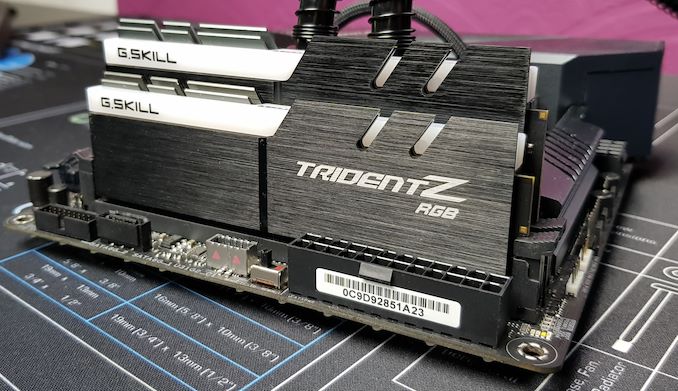
Comparing the smaller standard DDR4 to the newer DDR4 DC
The G.Skill TridentZ DC RGB memory doesn't differ stylistically from the 'standard' G.Skill TridentZ RGB memory. The main and only difference is in its height with the DC RAM measuring at a height of 60 mm, whereas the regular G.Skill TridentZ RGB sticks have a maximum height of 45 mm. This means the G.Skill DC modules are 33% bigger in size than the regular model. The heatsinks are made from aluminium and have a brushed finish, with one side grey and the other side black.
Along the top of the G.Skill TridentZ RGB DC memory is a plastic strip which diffuses the integrated addressable RGB LEDs. The RGB can be controlled by the ASUS AURA software or via G.Skill's own software.
ASUS and G.Skill both recommend users use liquid cooling methods on the CPU when this new memory is used due to potential issues when installing tower style air coolers that won't likely fit. This is due to the height clearance and the obstruction between the memory and either the side fans on a tower or the tower itself. For users angling the airflow top-to-bottom, the new memory can get in the way of heatpipes that like to stick out.
Although there is no information in regards to availability as of yet, the G.Skill TridentZ RGB DC memory is available in three different frequencies configurations. The first two are DDR4-3000 and DDR4-3200 kits with CL14-14-14-34 latency timings. The other kit is DDR4-3200 with slightly looser timings. All these kits have an operation voltage of 1.35 V and fully supports XMP 2.0 SPD. The kits are available in 64 GB kits (2x32 GB) only, are currently compatibility limited to three ASUS Z390 motherboards, and they operate in dual-channel.
| G.Skill's Trident Z RGB DC Kits for ASUS Z390 Platform | ||||||
| Speed | CL Timing | Voltage | Kit Config. |
PN | ||
| DDR4-3000 | CL14-14-14 34 | 1.35 V | 2×32 GB | F4-3000C14D-64GTZDC | ||
| DDR4-3200 | CL14-14-14 34 | F4-3200C14D-64GTZDC | ||||
| CL14-15-15 35 | F4-3200C14D-64GTZDCB | |||||
No pricing information has been provided by G.Skill or ASUS, but we expect pricing to be at the high end of three figures.
Comparing 2x32GB DDR4-2400 to 2x16GB DDR4-2400
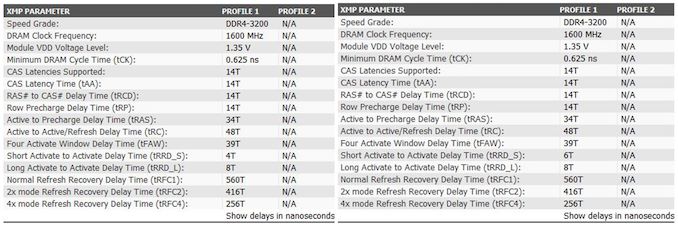
G.Skill TridentZ RGB DC (Left) and TridentZ RGB (Right) XMP 2.0 Latency Timings
When comparing the G.Skill DDR4-3200 14-14-14-34 TridentZ RGB DC UDIMMs (2x32 GB) to its DDR4-3200 14-14-14-34 TridentZ RGB UDIMMs (2x16GB), not much is different in terms of latencies. The only difference is that the DC TridentZ has a slightly higher tRRD_S which represents the number of clock cycles between activated commands from a different bank group.


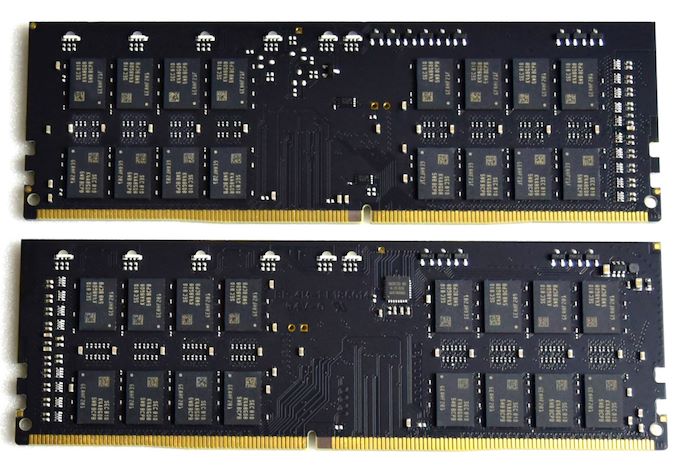

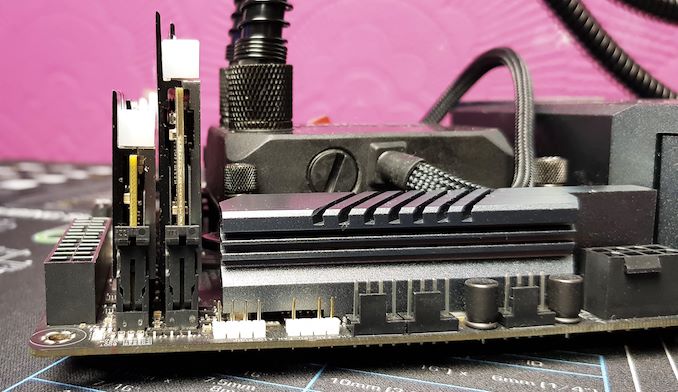
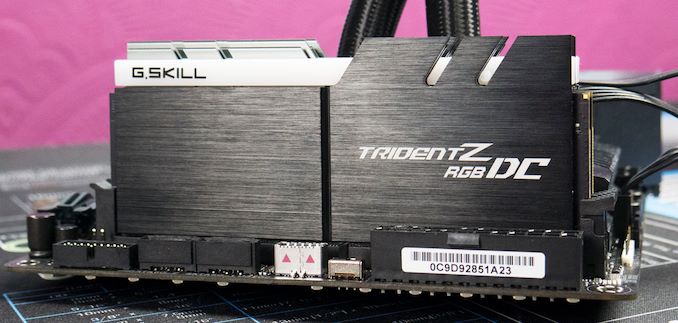








50 Comments
View All Comments
Alim345 - Wednesday, January 23, 2019 - link
It’s not clear whether it is possible to use four sticks. Probably it is not since those sticks replicate what should happen in motherboard.Targon - Thursday, January 24, 2019 - link
Much of that would be a function of the chipset/BIOS and the memory controller which is on the CPU these days. These double height modules can't directly talk to the memory controller as if they are two modules, because the memory slots themselves and how they talk to the chipset/memory controller/CPU are not different.That is why I wanted to see at least an attempt to get these to work with a socket AM4 system and see how they show up. Going from 1T or 2T to 2T or 4T for the memory is probably the issue, and if the chipset would even allow it. Asking Asus if they have plans to allow DDR4 to run with a 4T command rate on more boards would be worth the call.
nevcairiel - Wednesday, January 23, 2019 - link
Since one of those DIMMs basically acts like two DIMMs, you probably cannot use two of them on the same channel, since that would require supporting 4 DIMMs on the same channel.Targon - Thursday, January 24, 2019 - link
I don't think it works that way. Yes, internally each one is working as if it was two, but how the module talks to the BIOS/chipset/processor is the big question. Does the BIOS need to support a 4T command rate on the memory for these to work, and if so, that explains why support is limited.Bp_968 - Thursday, January 24, 2019 - link
He explained in the article that the way memory channels are handled that the traces are daisy chained or combined. These dimms act as 2 dimms slapped onto one card and won't work stacked 2 too a channel (because then you'd have 4 dimms on a channel).Above and beyond that you also have the fact that now 32GB modules exist which render these far less useful. There are very very few scenarios where you'd want 128GB of ram and not want it to be ECC RAM. Any sort of server and many workstation tasks I'd much prefer to use ECC ram instead.
yuhong - Wednesday, January 23, 2019 - link
Even Intel don't usually update ARK or the datasheet.alpha754293 - Wednesday, January 23, 2019 - link
Maybe I'm missinng something here - but I don't understand why people just don't get 32 GB DDR4-2666 ECC Registered DIMMS like this one (https://www.newegg.com/Product/Product.aspx?Item=N... and be done with it?It's going to run about the same price and they can just overclock it.
Wixman666 - Wednesday, January 23, 2019 - link
Because most boards don't run ECC memory. These are a niche product to get 64GB on boards that only have 2 slots. Lots of memory doesn't overclock well. You're making assumptions with your statement that are completely off base.CheapSushi - Thursday, January 24, 2019 - link
Does that mean ECC RAM will NOT WORK AT ALL or just the ECC portion, soft error correcting, won't work but it'll show up like regular RAM?alpha754293 - Thursday, January 24, 2019 - link
I've used ECC memory on consumer grade boards. All that happens is that the ECC part of the ECC, Registered RAM gets disabled and the rest of the DIMM module functions like a UDIMM instead of a RDIMM."You're making assumptions with your statement that are completely off base."
Yes! Which is why I literally said: "Maybe I'm missinng something here - but I don't understand why people just don't get 32 GB DDR4-2666 ECC Registered DIMMS like this one (https://www.newegg.com/Product/Product.aspx?Item=N... and be done with it?"
Lots of memory don't overclock well is just a broad and generic statement that can also be applied to these modules as well.
The fact of the matter is that DDR4-3000 and DDR4-3200 modules ARE overclocked by default anyways because those speeds aren't part of the JEDEC JESD79-4 spec (p.163).
Here is a 32 GB module from Micron Technology, DDR4-3200, ECC Registered: https://www.ebay.com/itm/Micron-MTA36ASF4G72PZ-3G2...
The point being that a) they exist already and b) you should be able to disable the ECC, registered capabilities of these DIMMs. (I've never had a consumer grade board that didn't know how to ignore the ECC registered capabilities of RDIMMs.)
In other words, you can already do this with existing modules that you can buy, at those speeds, "second" hand (which tells you a little bit about the maturity of the tech).